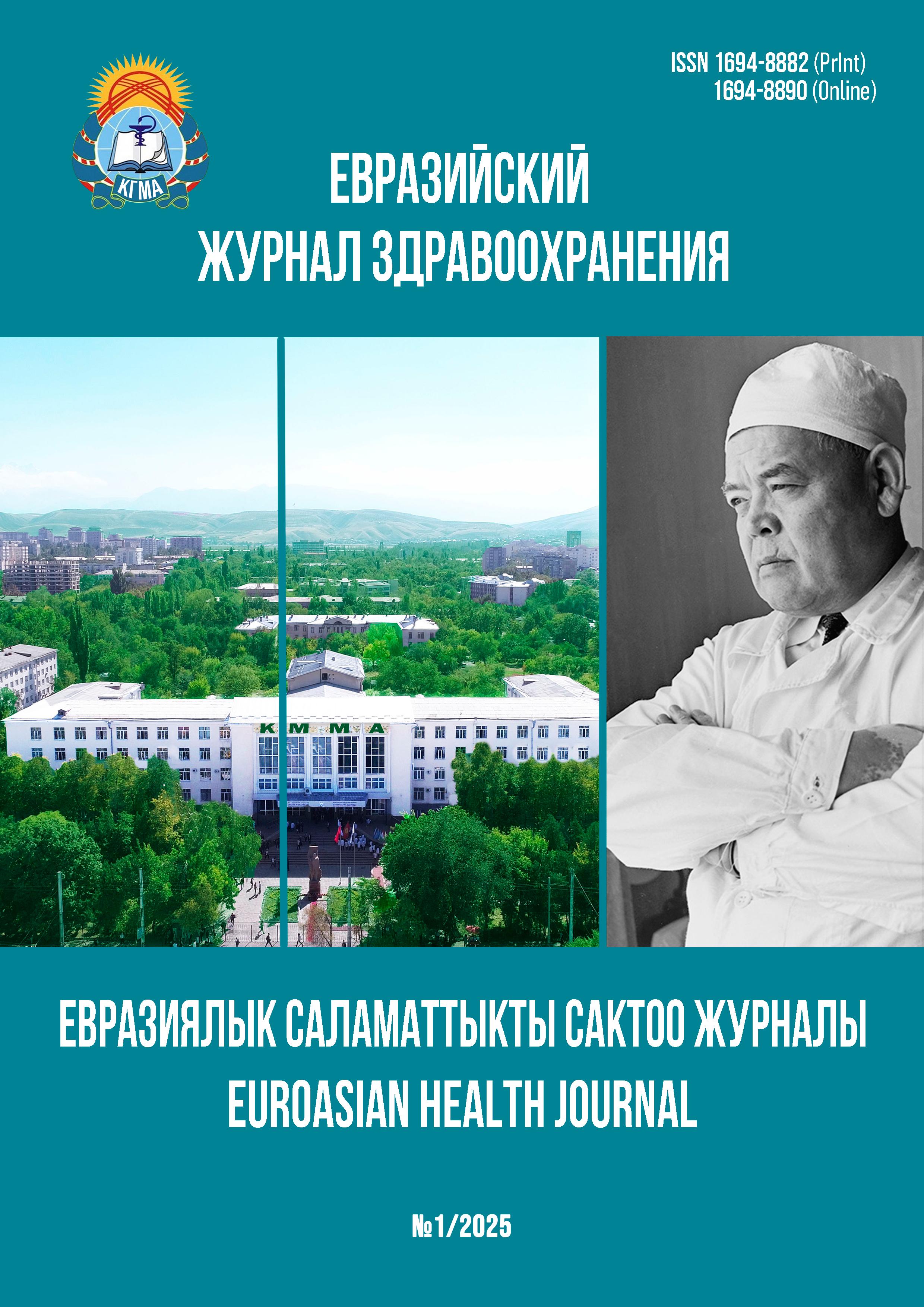ВЗАИМОСВЯЗЬ ФАКТОРОВ РИСКА СЕРДЕЧНО-СОСУДИСТЫХ ЗАБОЛЕВАНИЙ С ЖЕСТКОСТЬЮ СОСУДОВ АРТЕРИАЛЬНОГО РУСЛА И ПОКАЗАТЕЛЯМИ ОТРАЖЕННОЙ ВОЛНЫ
DOI:
https://doi.org/10.54890/1694-8882-2025-1-74Аннотация
Измерение артериальной жесткости в настоящее время чаще используется в исследовательских целях, чем в клинической практике. Повышение показателей артериальной жесткости являются прямым доказательством повреждений целевых органов, при этом скорость распространения пульсовой волны считается биомаркером сосудистого повреждения и важным предиктором определения глобального сердечно-сосудистого риска пациента, учитывая, что классические оценки риска, в основном при промежуточном риске, плохо подходят для прогнозирования сердечно - сосудистых исходов. Традиционные модели прогнозирования риска, такие как Фремингемская шкала риска, обычно используются для расчета индивидуального риска для первичной профилактики сердечно-сосудистых заболеваний, однако эта оценка имеет ограничения, такие как снижение точности в некоторых этнических группах и отсутствие включения определенных факторов риска. Добавление параметров жесткости сосудов артериального русла и показателей отраженной волны к классической стратификации сердечно-сосудистого риска может перевести людей в более высокую категорию риска, что подразумевает изменения в лечении, направленные на более высокую сердечно-сосудистую защиту. В обзорной статье представлены данные взаимосвязи факторов сердечно-сосудистого риска и показателей жесткости артерий и параметров отраженной волны.
Ключевые слова:
сердечно-сосудистые заболевания, факторы сердечно-сосудистых заболеваний, жесткость артерий, показатели отраженной волныБиблиографические ссылки
1. Zhu Y, Liu C, Zhang L, Fang Q, Zang S, Wang X. How to control the economic burden of treating cardio-cerebrovascular diseases in China? Assessment based on System of Health Accounts 2011. J Glob Health. 2020;10(1):010802. https://doi.org/10.7189/jogh.10.010802
2. Li J, Liu W, Peng F, Cao X, Xie X, Peng C. The multifaceted biology of lncR-Meg3 in cardio-cerebrovascular diseases. Front Genet. 2023;14:1132884. https://doi.org/10.3389/fgene.2023.1132884
3. Nawsherwan, Bin W, Le Z, Mubarik S, Fu G, Wang Y. Prediction of cardiovascular diseases mortality- and disability-adjusted life-years attributed to modifiable dietary risk factors from 1990 to 2030 among East Asian countries and the world. Front Nutr. 2022;9:898978. https://doi.org/10.3389/fnut.2022.898978
4. Di Cesare M, Perel P, Taylor S, Kabudula C, Bixby H, Gaziano TA, et al. The Heart of the World. Glob Heart. 2024;19(1):11. https://doi.org/10.5334/gh.1288
5. Zhang K, Jiang Y, Zeng H, Zhu H. Application and risk prediction of thrombolytic therapy in cardio-cerebrovascular diseases: a review. Thromb J. 2023;21(1):90. https://doi.org/10.1186/s12959-023-00532-0
6. Lindstrom M, DeCleene N, Dorsey H, Fuster V, Johnson CO, LeGrand KE, et al. Global Burden of Cardiovascular Diseases and Risks Collaboration, 1990-2021. J Am Coll Cardiol. 2022;80(25):2372-2425. https://doi.org/10.1016/j.jacc.2022.11.001
7. Di Cesare M, Perel P, Taylor S, Kabudula C, Bixby H, Gaziano TA, et al. The Heart of the World. Glob Heart. 2024;19(1):11. https://doi.org/10.5334/gh.1288
8. Budoff MJ, Alpert B, Chirinos JA, Fernhall B, Hamburg N, Kario K, et al. Clinical Applications Measuring Arterial Stiffness: An Expert Consensus for the Application of Cardio-Ankle Vascular Index. Am J Hypertens. 2022;35(5):441-453. https://doi.org/10.1093/ajh/hpab178
9. Nichols WW, Denardo SJ, Wilkinson IB, McEniery CM, Cockcroft J, O'Rourke MF. Effects of arterial stiffness, pulse wave velocity, and wave reflections on the central aortic pressure waveform. J Clin Hypertens (Greenwich). 2008;10(4):295-303. https://doi.org/10.1111/j.1751-7176.2008.04746.x
10. Pierce GL, Coutinho TA, DuBose LE, Donato AJ. Is It Good to Have a Stiff Aorta with Aging? Causes and Consequences. Physiology (Bethesda). 2022;37(3):154-173. https://doi.org/10.1152/physiol.00035.2021
11. Agbaje AO. Arterial stiffness precedes hypertension and metabolic risks in youth: a review. J Hypertens. 2022;40(10):1887-1896. https://doi.org/10.1097/ HJH.0000000000003239
12. Цой Л.Г., Сабиров И.С., Полупанов А.Г. Состояние эндотелиальной функции у больных ишемической болезнью сердца пожилого возраста, осложненной хронической сердечной недостаточностью в процессе лечения бета-блокатором бисопрололом. Вестник Кыргызско-Российского Славянского университета. 2021;21(1):93-97.
13. Scicchitano P, Cortese F, Gesualdo M, De Palo M, Massari F, Giordano P, et al. The role of endothelial dysfunction and oxidative stress in cerebrovascular diseases. Free Radic Res. 2019;53(6):579-595. https://doi.org/10.1080/10715762.2019. 1620939
14. Полупанов А.Г., Залова Т.Б., Рысматова Ф.Т., Дуйшеналиева М.Т., Романова Т.А., Джумагулова А.С. Взаимосвязь концентрации фактора некроза опухоли альфа и интерлейкина-10 с развитием фатальных и нефатальных осложнений у больных эссенциальной гипертензией в процессе среднесрочного наблюдения. Артериальная гипертензия. 2019;25(5):540–548. https://doi.org/10.18705/1607-419X-2019-25-5-540-54
15. Su JH, Luo MY, Liang N, Gong SX, Chen W, Huang WQ, et al. Interleukin-6: A Novel Target for Cardio-Cerebrovascular Diseases. Front Pharmacol. 2021;12:745061. https://doi.org/10.3389/fphar.2021.745061
16. Kim HL. Arterial stiffness and hypertension. Clin Hypertens. 2023;29(1):31. https://doi.org/10.1186/s40885-023-00258-1
17. Kalra L, Rambaran C, Chowienczyk P, Goss D, Hambleton I, Ritter J, et al. Ethnic differences in arterial responses and inflammatory markers in Afro-Caribbean and Caucasian subjects. Arterioscler Thromb Vasc Biol. 2005;25(11):2362-2367. https://doi.org/10.1161/01.ATV.0000183887.76087.6a
18. McNally RJ, Boguslavskyi A, Malek R, Floyd CN, Cecelja M, Douiri A, et al. Influence of Blood Pressure Reduction on Pulse Wave Velocity in Primary Hypertension: A Meta-Analysis and Comparison With an Acute Modulation of Transmural Pressure. Hypertension. 2024;81(7):1619-1627.https://doi.org/10.1161/HYPERTENSIONAHA.123.22436
19. Mitchell GF, Guo CY, Benjamin EJ, Larson MG, Keyes MJ, Vita JA, et al. Cross-sectional correlates of increased aortic stiffness in the community: the Framingham Heart Study. Circulation. 2007;115(20):2628-2636. https://doi.org/10.1161/ CIRCULATIONAHA.106.667733
20. Karaki M, Kunimatsu N, Watanabe K, Tomoto T, Fukuie M, Sugawara J, et al. The validity of carotid-femoral pulse wave velocity in the seated posture as an index of central arterial stiffness. Am J Physiol Regul Integr Comp Physiol. 2025;328(2):R145-R153. https://doi.org/10.1152/ajpregu.00073.2024
21. Brillante DG, O'Sullivan AJ, Howes LG. Arterial stiffness indices in healthy volunteers using non-invasive digital photoplethysmography. Blood Press. 2008;17 (2):116-123. https://doi.org/10.1080/08037050802059225
22. Garoffolo G, Pesce M. Vascular dysfunction and pathology: focus on mechanical forces. Vasc Biol. 2021;3(1):R69-R75. Published 2021 Jun 9. https://doi.org/ 10.1530/VB-21-0002
23. Schiffrin EL. Vascular stiffening and arterial compliance. Implications for systolic blood pressure. Am J Hypertens. 2004;17(12 Pt 2):39S-48S. https://doi.org/ 10.1016/j.amjhyper.2004.08.019
24. Safar ME. Pulse pressure, arterial stiffness, and cardiovascular risk. Curr Opin Cardiol. 2000;15(4):258-263. https://doi.org/10.1097/00001573-200007000-00009
25. MacMahon SW, Macdonald GJ. Antihypertensive treatment and plasma lipoprotein levels. The associations in data from a population study. Am J Med. 1986;80(2A):40-47. https://doi.org/10.1016/0002-9343(86)90159-2
26. Cooney MT, Vartiainen E, Laatikainen T, Juolevi A, Dudina A, Graham IM. Elevated resting heart rate is an independent risk factor for cardiovascular disease in healthy men and women [published correction appears in Am Heart J. 2010 Jul;160(1):208. Laakitainen, Tinna [corrected to Laatikainen, Tiina]. Am Heart J. 2010;159(4):612-619.e3. https://doi.org/10.1016/j.ahj.2009.12.029
27. Kase M, Iijima T, Niitani T, Sagara M, Sakurai S, Tomaru T, et al. Relationship between reduced heart rate variability and increased arterial stiffness evaluated by the cardio-ankle vascular index in people with type 2 diabetes. Diabetol Int. 2022;14(1):94-102. Published 2022 Sep 29. https://doi.org/10.1007/s13340-022-00604-y
28. Park BJ, Lee HR, Shim JY, Lee JH, Jung DH, Lee YJ. Association between resting heart rate and arterial stiffness in Korean adults. Arch Cardiovasc Dis. 2010;103(4):246-252. https://doi.org/10.1016/j.acvd.2010.03.004
29. DuPont JJ, Kenney RM, Patel AR, Jaffe IZ. Sex differences in mechanisms of arterial stiffness. Br J Pharmacol. 2019;176(21):4208-4225. https://doi.org/10.1111 /bph.14624
30. Naka KK, Papathanassiou K, Bechlioulis A, Kazakos N, Pappas K, Tigas S, et al. Determinants of vascular function in patients with type 2 diabetes. Cardiovasc Diabetol. 2012;11:127. https://doi.org/10.1186/1475-2840-11-127
31. Staef M, Ott C, Kannenkeril D, Striepe K, chiffer M, Schmieder RE, Bosch A. Determinants of arterial stiffness in patients with type 2 diabetes mellitus: a cross sectional analysis. Sci Rep. 2023;13:8944. https://doi.org/10.1038/s41598-023-35589-4
32. Li Y, Liu Y, Liu S, Gao M, Wang W, Chen K, et al. Diabetic vascular diseases: molecular mechanisms and therapeutic strategies. Signal Transduct Target Ther. 2023;8(1):152. https://doi.org/10.1038/s41392-023-01400-z
33. Karabaeva RZ, Vochshenkova TA, Mussin NM, Albayev RK, Kaliyev AA, Tamadon A. Epigenetics of hypertension as a risk factor for the development of coronary artery disease in type 2 diabetes mellitus. Front Endocrinol (Lausanne). 2024;15:1365738. https://doi.org/10.3389/fendo.2024.1365738
34. Tsioufis C, Dimitriadis K, Selima M, Thomopoulos C, Mihas C, Skiadas I, et al. Low-grade inflammation and hypoadiponectinaemia have an additive detrimental effect on aortic stiffness in essential hypertensive patients. Eur Heart J. 2007;28(9):1162-1169. https://doi.org/10.1093/eurheartj/ehm089
35. Jerrard-Dunne P, Mahmud A, Feely J. Ambulatory arterial stiffness index, pulse wave velocity and augmentation index--interchangeable or mutually exclusive measures? J Hypertens. 2008;26(3):529-534. https://doi.org/10.1097/HJH. 0b013e3282f35265
36. Williams B, Mancia G, Spiering W, Agabiti Rosei E, Azizi M, Burnier M, et al. 2018 ESC/ESH Guidelines for the management of arterial hypertension: The Task Force for the management of arterial hypertension of the European Society of Cardiology and the European Society of Hypertension: The Task Force for the management of arterial hypertension of the European Society of Cardiology and the European Society of Hypertension [published correction appears in J Hypertens. 2019 Jan;37(1):226. https://doi.org/10.1097/HJH.0000000000002017.]. J Hypertens. 2018;36(10):1953-2041. https://doi.org/10.1097/HJH.0000000000001940
37. Loehr LR, Meyer ML, Poon AK, Selvin E, Palta P, Tanaka H, et al. Prediabetes and Diabetes Are Associated With Arterial Stiffness in Older Adults: The ARIC Study. Am J Hypertens. 2016;29(9):1038-1045. https://doi.org/10.1093/ajh/hpw036
38. Vatner SF, Zhang J, Vyzas C, Mishra K, Graham RM, Vatner DE. Vascular Stiffness in Aging and Disease. Front Physiol. 2021;12:762437. https://doi.org/10.3389/ fphys.2021.762437
39. Kim JM, Kim SS, Kim IJ, Kim JH, Kim BH, Kim MK, et al. Arterial stiffness is an independent predictor for risk of mortality in patients with type 2 diabetes mellitus: the REBOUND study. Cardiovasc Diabetol. 2020;19(1):143. Published 2020 Sep 22. https://doi.org/10.1186/s12933-020-01120-6
40. Din JN, Ashman OA, Aftab SM, Jubb AW, Newby DE, Flapan AD. Increased arterial stiffness in healthy young South Asian men. J Hum Hypertens. 2006;20(2):163-165. https://doi.org/10.1038/sj.jhh.1001961
41. Pinto ES, Mensah R, Meeran K, Cameron JD, Murugaesu N, Bulpitt CJ, et al. Peripheral arterial compliance differs between races: comparison among Asian, Afro-Caribbeans, and white Caucasians with type 2 diabetes. Diabetes Care. 2005;28(2):496. https://doi.org/10.2337/diacare.28.2.496
42. Polupanov AG, Khalmatov AN, Altymysheva AT, Lunegova OS, Mirrakhimov AE, Sabirov IS, et al. The prevalence of major cardiovascular risk factors in a rural population of the chui region of Kyrgyzstan: the results of an epidemiological study. The Anatolian Journal of Cardiology. 2020;24(3):183-191. https://doi.org/ 10.14744/AnatolJCardiol.2020.59133







